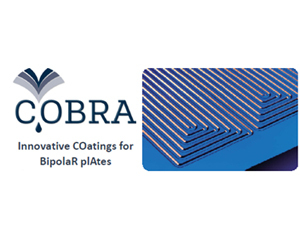COBRA
The project:
The COBRA project represents a mature approach towards reaching the technical and commercial targets of bipolar plates for automotive stack development based on the FCH-JU 2013 AIP targets.COBRA aims at developing and improving the PEMFC stack components and especially metallic bipolar plates. These innovative solutions can be then accessed and shared by several OEM’s for their individual system integration work and mobility platforms. The COBRA project is built so as to conceive an innovative, performant, durable and low cost bipolar plate technology based on the 2013 AIP targets.
For automotive fuel cell stacks and most of the automotive OEM’s have already chosen metallic bipolar plate as technological solutions for cost and process ability concerns. Thus, the COBRA project focuses on two main topics to reach the performances objectives: the improvements of manufacturing process and the development of new coatings as alternative to expensive state-of-art gold coating.
The coating layer shall indeed be good electronic conductor with low interfacial contact resistance (< 10 mohm.cm²) and corrosion resistant under fuel cell conditions. The technological approach is a step by step method where new coatings are first developed, characterized on small stainless steel samples for contact resistance and corrosion resistance in liquid electrolyte. Different coating methods by sol-gel methods, physical vapor deposition and electrochemical deposition were used to synthetize “non-noble metal-carbon” composites, carbide compounds and conductive ceramics.
Meanwhile, the optimization of hydroforming (instead of classic stamping), welding, cutting and sealing deposit processes was studied and applied on a generic bipolar plate design (from previous automotive developments) as an “open object” and tangible proof of concept of the overall chain of manufacturing within the consortium.
Pre-selected coating materials and process are up-scaled to be adapted to the final plate design and then characterized under short PEMFC stack for performance and durability evaluation under representative automotive conditions using recommended FC-DLC (Dynamic Load Cycle) protocol. Periodic electrochemical measurements during the test campaign followed by post-mortem analyses make it possible to characterize the main degradations mechanisms observed and to check any heterogeneity of ageing phenomena on the active surface of the plate.
Fully power stacks were assembled with reference and the most suitable coating developed in the project for real field testing. Ex-situ systems, maritime conditions and automotive range extender applications are considered during the project. Those testing campaigns were preceded and followed by characterizations on laboratory test station to assess the impact of field operating conditions on the performances and components ageing.
Finally, the different project technologies are also evaluated with regard to economic considerations at different production scale based on detailed process description (production rate, facilities, raw materials, scrap rate, maintenance, human resources, work organization…). This evaluation shall be then compared to other projections from state-of-art.
Our role:
CIDETEC was the leader of the WP 4 (Assessment of the contamination of catalysts layers and membrane by the corrosion products released) and WP6 (Development of corrosion resistant and conductive new coatings for bipolar plates). The main tasks of CIDETEC in COBRA project were:
- Ex-situ electrochemical characterization of reference bipolar plates (WP3),
- Experimental characterization of catalyst in aggressive environment (WP4).
- Development of metal layers by pulse plating (WP6).
- Development bilayer systems consisting of metal layer and of sol-gel topcoats (WP6).
- Electrochemical characterization of bilayer systems and pulse plated coatings (WP6).
- Accelerated ageing tests (WP6).
- Furthermore, other contributions are in management, demonstration & dissemination.

Inicio: 01 | 04 | 2014
Fin: 31 | 03 | 2017
Presupuesto: 3.800.000 €
CIDETEC Energy Storage
Commissariat à l’énergieatomiqueet aux energies alternatives (CEA)
Borit NV
Impact Coatings AB
SymbioFCell SA (SFC)
Institut National des Sciences Appliquées de Lyon (INSA Lyon), Université de Lyon
Financiador
The COBRA project is supported by the 7th Framework Programme of the EuropeanCommission in the context of the Fuel Cells and Hydrogen Joint Undertaking (FCH-JU) publicprivate partnership.
Publicaciones
Presentación
DescargarSectores
- Energía
- Fabricantes de celdas de batería
- Transporte público / vehículos terrestres
Campos tecnológicos
- Fabricación de baterías
- Modelado y simulación de celdas
- Nuevas tecnologías y materiales para baterías
- Testeo de baterías












